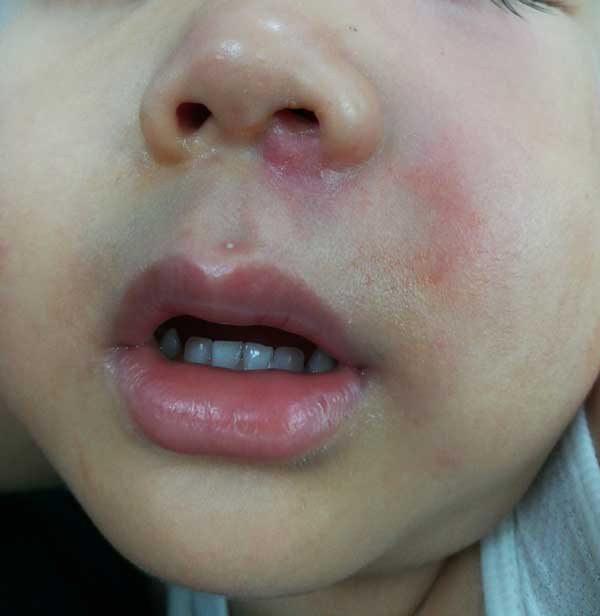With her solid experience in pediatric dermatology acquired at Necker-Enfants Malades Hospital, and Saint-Louis Hospital Paris, Dr Halabi-Tawil will take care of your child’s skin issues with the most appropriate treatment and smooth care.
Pediatric Dermatology and Teenagers
Atopic dermatitis/Eczema

On average, one of every 10 children will develop eczema, and it can manifest very early in life. Eczema causes a red, scaly and itchy rash on the child’s body, and the itching can sometimes affect his sleep.
Dr Halabi-Tawil will advise a global approach to atopic eczema that sometimes involve lifestyle adjustments.
Impetigo

Impetigo is a very frequent skin infection of childhood. It’s usually caused by one of two bacteria: Staphylococcus aureus or Streptococcus pyogenes. It is also highly contagious. It usually manifests as crusty yellow plaques, most frequently located around the nose and mouth, but it can be localized anywhere else.
Warts

Warts are another extremely common infection of childhood, caused by viruses of the human papillomavirus (HPV) family. They can affect any area of the body, but most frequently the fingers, hands, and feet. They are usually painless unless they’re located on the soles of the feet. Warts are very contagious, and are usually treated with cryotherapy as an in-clinic procedure. If preferred, a topical treatment can be applied.
Molluscum contagiosum

Molluscum contagiosum is another common viral infection of childhood that looks like small pink or pearly white growths on the skin. As its name indicates, it is a highly contagious, but benign condition. Several options of treatments are possible and will be discussed and given according to parents’ preference when possible.
Ringworm

Ringworm is a frequent and contagious infection on the skin or scalp, caused by a fungus. On the skin, it manifests as one or several pink circles whose edges are raised. It may itch or sting. On the scalp, it may look like dandruff but with evolution hair can break off and leave patches of baldness. It can easily be treated and hair will grow back.
Diaper rash

Diaper rash is an extremely common condition that usually clears up with simple changes in diapering. It can result from irritation from stool or urine, allergies or infection. When it lasts more than a few days, it’s recommended to be checked since it might be caused by a yeast called Candida albicans. Simple, and safe topical treatments adapted to babies will be prescribed.
Genodermatosis

Genodermatosis are inherited disorders with anomalies of the skin, that frequently manifest in early infancy, or during childhood. A wide variety of skin conditions are grouped under this name, Congenital bullous diseases such as epidermolysis bullosa, extremely scaly skin called ichtyosis, neurobromatosis, xeroderma pigmentosum are some examples of genodermatosis.
Early recognition is of utmost importance in certain cases because they can be life-threatening, or can carry a risk of associated abnormalities, including malignancy.
Psoriasis

Psoriasis is a chronic disease of the skin, roughly affecting 2–3% of the population. It usually manifests as red and scaly plaques on the skin, mostly on the knees, elbows, scalp and back. It can also affect the nails, the folds (inverse psoriasis), the palms and soles, and even the joints. It is an immune mediated disease, with both genetic (familial) and environmental (eg. infections) components. It usually affects children after 15y/o but can sometimes affect children younger than 10y/o, or even infants. When one parent has the disease, the child has a 10% probability of contracting it. When both parents have psoriasis, this probability increases to 50%.
Although psoriasis cannot be cured, there are several therapies to control it and get the patient in remission (free of symptoms).
Acne and oily skin

Acne is teenagers’ number one skin issue, affecting roughly 85% of adolescents. Hormonal changes during adolescence cause the sebaceous glands to become enlarged, and sebum production increases, paving the way to pores getting clogged up with too much sebum, dead skin cells, and bacteria.
A global approach to acne, including lifestyle changes, would be recommended as the key to a successful treatment. If needed, a ‘nettoyage’ can also be performed as an in-clinic procedure.
Excessive sweating/Hyperhidrosis

Hyperhidrosis is a very uncomfortable condition that affects more than 2% of us. In most cases, it tends to be localized (armpits, or palms and soles) and usually starts at adolescence.
Many treatment options exist, depending on the cause and extent of territories involved.

